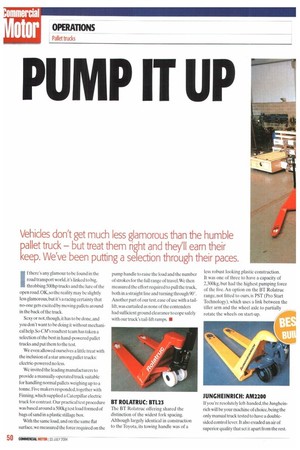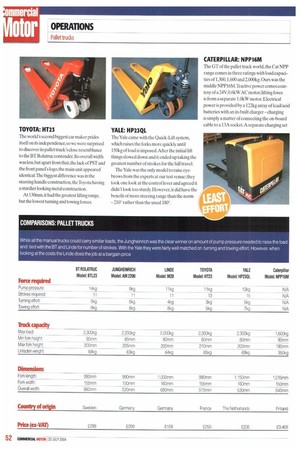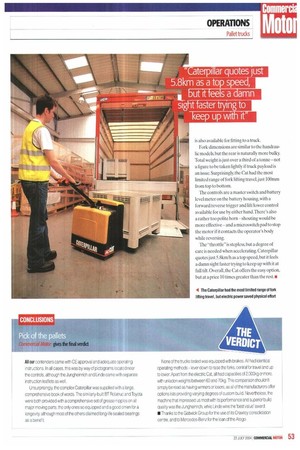PUMP IT UP
Page 52

Page 53

Page 54

Page 55

If you've noticed an error in this article please click here to report it so we can fix it.
Vehicles don't get much less glamorous than the humble pallet truck — but treat them right and they'll earn their keep. We've been putting a selection through their paces.
If there's any glamour to be found in the road transport world,it's linked to big, throbbing 500hp trucks and the lure of the open road. OK, so the reality may be slightly less glamorous, but it's a racing certainty that no-one gets excited by moving pallets around in the back of the truck.
Sexy or not, though, it has to be done, and you don't want to be doing it without mechanical help. So C'M's roadtest team has taken a selection of the best in hand-powered pallet trucks and put them to the test.
We even allowed ourselves a little treat with the inclusion of a star among pallet trucks: electric-powered no less.
We invited the leading manufacturers to provide a manually-operated truck suitable for handling normal pallets weighing up to a tonne. Five makers responded, together with Finning, which supplied a Caterpillar electric truck for contrast. Our practical test procedure was based around a 500kg test load formed of bags of sand in a plastic stillage box.
With the same load, and on the same flat surface, we measured the force required on the pump handle to raise the load and the number of strokes for the full range of travel. We then measured the effort required to pull the truck, both in a straight line and turning through 90°. Another part of our test , ease of use with a taillift, was curtailed as none of the contenders had sufficient ground clearance to cope safely with our truck's tail-lift ramps. • BT ROLATRUC: BTL23 The BT Rolatruc offering shared the distinction of the widest fork spacing. Although largely identical in construction to the Toyota, its towing handle was of a less robust looking plastic construction. It was one of three to have a capacity of 2,300kg, but had the highest pumping force of the five. An option on the BT Rolatruc range, not fitted to ours, is PST (Pro Start Technology), which uses a link between the tiller arm and the wheel axle to partially _ rotate the wheels on start-up.
JUNGHEINRICH: AM2200 If you're resolutely left-handed, the Jungheinrich will be your machine of choice, being the only manual truck tested to have a doublesided control lever. It also exuded an air of superior quality that set it apart from the rest. Attention to detail includes point of balance and slinging point markings.
It combined the lightest handle pressure with the equal lowest number of strokes; it was also the lightest contender.
LINDE: M20
Jointly with the BT Rolatrue, the Linde has the widest fork spacing of the trucks supplied for test, enhancing stability at the cost of some manoeuvrability. Despite this, it had the lowest capacity of the group. In all other respects the Linde's performance pretty well defined the middle of the road.
TOYOTA: HT23
The work! 's second biggest car maker prides itself on its independence, so we were surprised to discover its pallet truck's close resemblance to the BT Rolatruc contender. Its overall width was less, but apart from that, the lack of PST and the front panel's logo, the main unit appeared identicaLThe biggest difference was in the steering handle construction, the Toyota having a sturdier looking metal construction.
At 1311nin,it had the greatest lifting range, but the lowest turning and towing forces
YALE: H P23QL
The Yale came with the Quick-Lift system, which raises the forks more quickly until 150kg of load is imposed. After the initial lift things slowed down and it ended up taking the greatest number of strokes for the full travel.
The Yale was the only model to raise eyebrows from the experts at our test venue; they took one look at the control lever and agreed it didn't look too sturdy. However, it did have the benefit of more steering range than the norm —210° rather than the usual 180°.
CATERPILLAR: NPP16M
The GT of the pallet truck world, the Cat NPP range comes in three ratings with load capacities of 1,300,1.600 and 2,000kg. Ours was the middle NPP16M.Tractive power comes courtesy of a 24V,0.6kW AC motor;lifting force is from a separate 1.0kW motor. Electrical power is provided by a 122kg array of lead/acid batteries with an in-built charger — charging is simply a matter of connecting the on-board cable to a 13A socket. A separate charging set is also available for fitting to a truck.
Fork dimensions are similar to the handraulic models, but the rear is naturally more bulky. Total weight is just over a third of a tonne not a figure to be taken lightly if truck payload is an issue. Surprisingly, the Cat had the most limited range of fork lifting travel. just 100mm from top to bottom.
The controls are a master switch and battery level meter on the battery housing, with a forward/reverse trigger and lift/lower control available for use by either handlliere's also a rather too polite horn shouting would be more effective and a microswitch pad to stop the motor if it contacts the operator's body while reversing.
The "throttle" is stepless, but a degree of care is needed when accelerating. Caterpillar quotes just 5.8km/h as a top speed, but it feels a damn sight faster trying to keep up with it at full tilt. Overall, the Cat offers the easy option, but at a price 10 times greater than the rest. •






























































































































































































